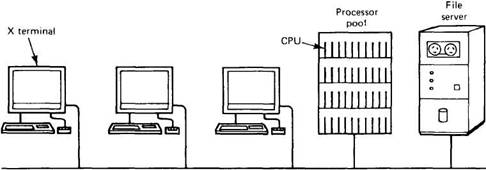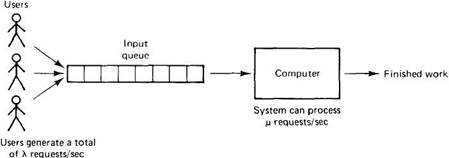Книга: Distributed operating systems
4.2.3. The Processor Pool Model
4.2.3. The Processor Pool Model
Although using idle workstations adds a little computing power to the system, it does not address a more fundamental issue: What happens when it is feasible to provide 10 or 100 times as many CPUs as there are active users? One solution, as we saw, is to give everyone a personal multiprocessor. However this is a somewhat inefficient design.
An alternative approach is to construct a processor pool, a rack full of cpus in the machine room, which can be dynamically allocated to users on demand. The processor pool approach is illustrated in Fig. 4-13. Instead of giving users personal workstations, in this model they are given high-performance graphics terminals, such as X terminals (although small workstations can also be used as terminals). This idea is based on the observation that what many users really want is a high-quality graphical interface and good performance. Conceptually, it is much closer to traditional timesharing than to the personal computer model, although it is built with modern technology (low-cost microprocessors).

Fig. 4-13. A system based on the processor pool model.
The motivation for the processor pool idea comes from taking the diskless workstation idea a step further. If the file system can be centralized in a small number of file servers to gain economies of scale, it should be possible to do the same thing for compute servers. By putting all the CPUs in a big rack in the machine room, power supply and other packaging costs can be reduced, giving more computing power for a given amount of money. Furthermore, it permits the use of cheaper X terminals (or even ordinary ASCII terminals), and decouples the number of users from the number of workstations. The model also allows for easy incremental growth. If the computing load increases by 10 percent, you can just buy 10 percent more processors and put them in the pool.
In effect, we are converting all the computing power into "idle workstations" that can be accessed dynamically. Users can be assigned as many CPUs as they need for short periods, after which they are returned to the pool so that other users can have them. There is no concept of ownership here: all the processors belong equally to everyone.
The biggest argument for centralizing the computing power in a processor pool comes from queueing theory. A queueing system is a situation in which users generate random requests for work from a server. When the server is busy, the users queue for service and are processed in turn. Common examples of queueing systems are bakeries, airport check-in counters, supermarket check-out counters, and numerous others. The bare basics are depicted in Fig. 4-14.
Queueing systems are useful because it is possible to model them analytically. Let us call the total input rate ? requests per second, from all the users combined. Let us call the rate at which the server can process requests ?. For stable operation, we must have ?>?. If the server can handle 100 requests/sec, but the users continuously generate 110 requests/sec, the queue will grow without bound. (Small intervals in which the input rate exceeds the service rate are acceptable, provided that the mean input rate is lower than the service rate and there is enough buffer space.)

Fig. 4-14. A basic queueing system.
It can be proven (Kleinrock, 1974) that the mean time between issuing a request and getting a complete response, T, is related to ? and ? by the formula

As an example, consider a file server that is capable of handling as many as 50 requests/sec but which only gets 40 requests/sec. The mean response time will be 1/10 sec or 100 msec. Note that when ? goes to 0 (no load), the response time of the file server does not go to 0, but to 1/50 sec or 20 msec. The reason is obvious once it is pointed out. If the file server can process only 50 requests/sec, it must take 20 msec to process a single request, even in the absence of any competition, so the response time, which includes the processing time, can never go below 20 msec.
Suppose that we have n personal multiprocessors, each with some number of CPUs, and each one forms a separate queueing system with request arrival rate ? and CPU processing rate ?. The mean response time, T, will be as given above. Now consider what happens if we scoop up all the CPUs and place them in a single processor pool. Instead of having n small queueing systems running in parallel, we now have one large one, with an input rate n? and a service rate n?. Let us call the mean response time of this combined system T1. From the formula above we find

This surprising result says that by replacing n small resources by one big one that is n times more powerful, we can reduce the average response time n-fold. This result is extremely general and applies to a large variety of systems. It is one of the main reasons that airlines prefer to fly a 300-seat 747 once every 5 hours to a 10-seat business jet every 10 minutes. The effect arises because dividing the processing power into small servers (e.g., personal workstations), each with one user, is a poor match to a workload of randomly arriving requests. Much of the time, a few servers are busy, even overloaded, but most are idle. It is this wasted time that is eliminated in the processor pool model, and the reason why it gives better overall performance. The concept of using idle workstations is a weak attempt at recapturing the wasted cycles, but it is complicated and has many problems, as we have seen.
In fact, this queueing theory result is one of the main arguments against having distributed systems at all. Given a choice between one centralized 1000-MIPS CPU and 100 private, dedicated, 10-MIPS CPUs, the mean response time of the former will be 100 times better, because no cycles are ever wasted. The machine goes idle only when no user has any work to do. This fact argues in favor of concentrating the computing power as much as possible.
However, mean response time is not everything. There are also arguments in favor of distributed computing, such as cost. If a single 1000-MIPS CPU is much more expensive than 100 10-MIPS CPUs, the price/performance ratio of the latter may be much better. It may not even be possible to build such a large machine at any price. Reliability and fault tolerance are also factors.
Also, personal workstations have a uniform response, independent of what other people are doing (except when the network or file servers are jammed). For some users, a low variance in response time may be perceived as more important than the mean response time itself. Consider, for example, editing on a private workstation on which asking for the next page to be displayed always takes 500 msec. Now consider editing on a large, centralized, shared computer on which asking for the next page takes 5 msec 95 percent of the time and 5 sec one time in 20. Even though the mean here is twice as good as on the workstation, the users may consider the performance intolerable. On the other hand, to the user with a huge simulation to run, the big computer may win hands down.
So far we have tacitly assumed that a pool of n processors is effectively the same thing as a single processor that is n times as fast as a single processor. In reality, this assumption is justified only if all requests can be split up in such a way as to allow them to run on all the processors in parallel. If a job can be split into, say, only 5 parts, then the processor pool model has an effective service time only 5 times better than that of a single processor, not n times better.
Still, the processor pool model is a much cleaner way of getting extra computing power than looking around for idle workstations and sneaking over there while nobody is looking. By starting out with the assumption that no processor belongs to anyone, we get a design based on the concept of requesting machines from the pool, using them, and putting them back when done. There is also no need to forward anything back to a "home" machine because there are none.
There is also no danger of the owner coming back, because there are no owners. In the end, it all comes down to the nature of the workload. If all people are doing is simple editing and occasionally sending an electronic mail message or two, having a personal workstation is probably enough. If, on the other hand, the users are engaged in a large software development project, frequently running make on large directories, or are trying to invert massive sparse matrices, or do major simulations or run big artificial intelligence or VLSI routing programs, constantly hunting for substantial numbers of idle workstations will be no fun at all. In all these situations, the processor pool idea is fundamentally much simpler and more attractive.
- 4.2. SYSTEM MODELS
- 4.2.4. A Hybrid Model
- 7.1.3. The Amoeba System Architecture
- 4.3. PROCESSOR ALLOCATION
- 4.4.4 The Dispatcher
- Introduction to Microprocessors and Microcontrollers
- About the author
- Chapter 7. The state machine
- Appendix E. Other resources and links
- Example NAT machine in theory
- The final stage of our NAT machine
- Compiling the user-land applications




